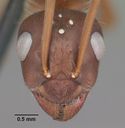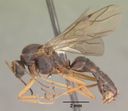Formica archboldi
Classification
- Phylum: Arthropoda
- Subphylum: Hexapoda
- Class: Insecta
- Order: Hymenoptera
- Superfamily: Formicoidea
- Family: Formicidae
- Subfamily: Formicinae
- Tribe: Formicini
- Genus: Formica
- Species: archboldi
Pronunciation
How to pronounce Formica archboldi: //ˈfɔr.mɪ.kə ɑrkˈboʊl.di//
These audio files are automatically generated. While they are not always 100% accurate, they are a good starting point.
Images






Summary
Formica archboldi is a unique predatory ant species that displays unusual behaviors, including the storage of trap-jaw ant heads in their nests, facilitated by their similar chemical profiles which provide a form of mimicry.
Physical Characteristics
Formica archboldi exhibits a specialized morphology adapted for predation, characterized by a robust build and strong mandibles for collecting and processing prey.
Identification Tips
Distinguished from other Formica species by their behavior and the specific collection of Odontomachus ant heads, along with their chemically similar cuticular hydrocarbon profiles to their prey.
Habitat
Primarily found in Scrub and sandhill ecosystems in northern Florida.
Distribution
Georgia, Alabama, Florida; most abundant in northern Florida.
Diet
Carnivorous; specializes in predation on Odontomachus (trap-jaw) ants, immobilizing them with formic acid and storing their heads.
Life Cycle
Details on the specific life cycle stages of Formica archboldi are not provided, further research would be required.
Reproduction
Information on reproductive strategies is not available in the provided data.
Predators
Data on specific predators of Formica archboldi is not provided.
Ecosystem Role
Plays a role as a predator in their ecosystem, impacting the population dynamics of their prey species, Odontomachus ants.
Economic Impact
No significant economic impact is reported.
Cultural Significance
Cultural significance is not detailed in the provided information.
Collecting Methods
- Manual collection in their natural habitats.
- Funnel traps for sampling ants.
Preservation Methods
- Ethanol preservation for specimens.
- Pinning for taxidermy display.
Evolution
Understanding of evolutionary relationships might be inferred from its predation specialization and chemical mimicry, but specific data is not available.
Similar Taxa
Misconceptions
There may be misunderstandings about their behavior, as they are often perceived merely as scavengers rather than active predators.
Tags
- Formica archboldi
- ant behavior
- predatory ants
- chemical mimicry
- Formicidae